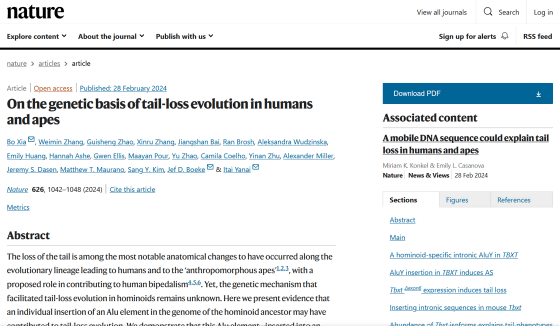We finally found out why monkeys have tails but humans don't

The ancestors of great apes, including
On the genetic basis of tail-loss evolution in humans and apes | Nature
https://www.nature.com/articles/s41586-024-07095-8

Change in gene code may explain how human anc | EurekAlert!
https://www.eurekalert.org/news-releases/1035840
We finally know why humans don't have tails | Live Science
https://www.livescience.com/health/genetics/we-finally-know-why-humans-dont-have-tails
Dr. Bo Xia of the Broad Institute , a biomedical and genome research center, researched how great apes evolved to lose their tails when he was a doctoral student at New York University's Grossman School of Medicine .
Previous research has shown that more than 100 genes are involved in tail development in vertebrates. The research team led by Shea hypothesized that ``at least one mutation in a gene related to tail development caused the loss of the tail in great apes,'' and compared tailless apes with tails. We compared the DNA of monkeys with this.
As a result of the analysis, it was found that the TBXT gene , which is related to the length of the tail in animals with tails, had inserted DNA that exists in great apes but does not exist in monkeys. 'Beau is truly a genius,' said study co-author Professor Itai Yanai of New York University Langone Health . 'He's found something different from what at least thousands of people have seen before.' .

DNA mutations play a major role in the evolution of animals, but in addition to direct mutations of genes involved in specific traits and functions, evolution is also caused by the insertion of DNA fragments called
DNA is transcribed into ribonucleic acid (RNA) and then encoded into proteins. However, not all of the transcribed RNA is encoded into proteins, but some of the RNA is spliced through a process called splicing before being encoded into proteins. is excluded. In this case, the gene sequences that are encoded by proteins are called exons , and those that are not encoded are called introns .
The Alu elements found to be associated with tail loss in great apes were inserted into introns that are spliced out, rather than into exons that eventually become proteins. The researchers report that Alu elements that remain in the same position in the human and great ape TBXT genes influence splicing, changing the code and structure of the final protein.
In fact, when the research team inserted the Alu element found in the human TBXT gene into mice, they showed that the mice's tails were missing or shortened. It was also found that mice that lost their tails had a higher prevalence of spina bifida due to neural tube malformation.
'Future experiments will explore ancient evidence that the loss of human tails contributed to neural tube birth defects such as spina bifida, which affects 1 in 1,000 human newborns,' Yanai said. Evolutionary trade-offs will be examined.'

Related Posts:







